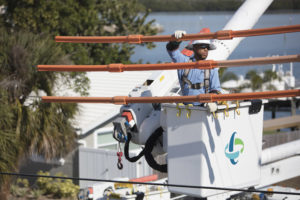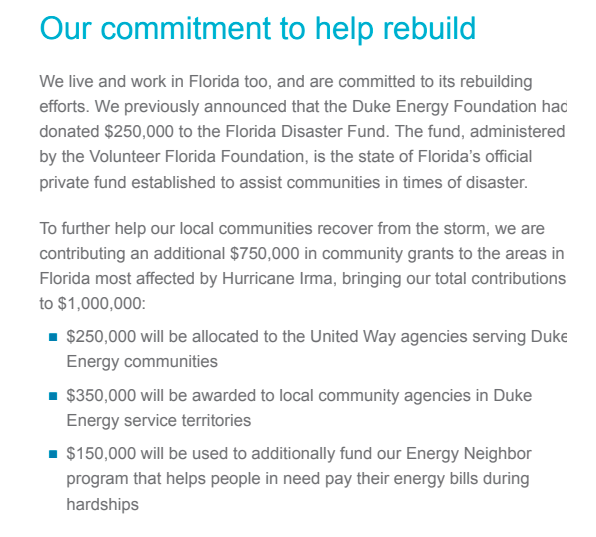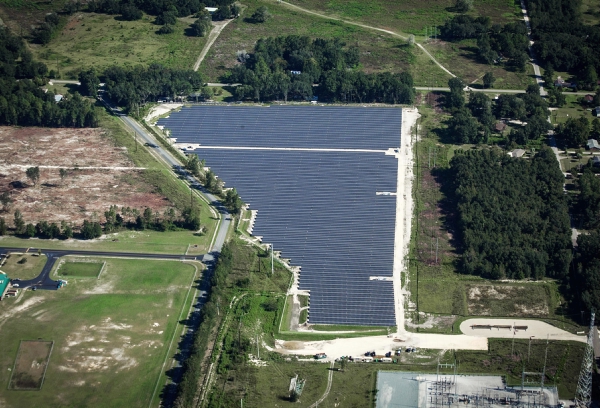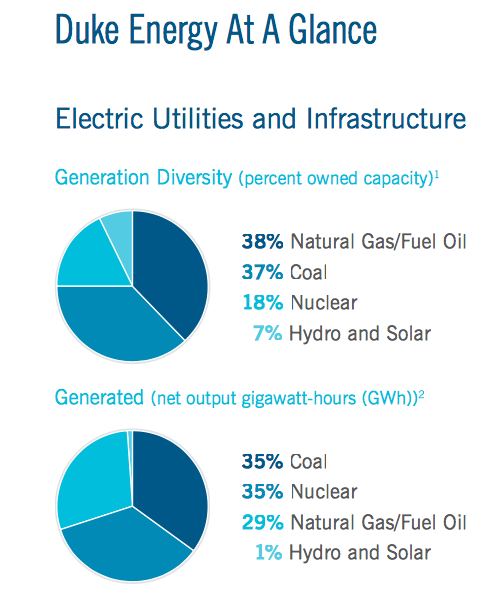By Eillin Delapaz

Atlantic hurricanes have been the strongest and most destructive on record according to Weather Underground. Irma, the season’s second hurricane not only made landfall in Florida as a category 4, but caused severe flooding and left millions of people without power— the Tampa Bay Times reports a total 62 percent of the state to be exact.
Duke Energy, which provides power for 1.8 million customers across Florida, had 1.2 million homes and businesses experience power outages for days. The Tampa Bay Times reports more than half of Pinellas County’s Duke customers were still without power late Tuesday, Sept. 17. Many people showed their frustrations with Duke, lashing out across social media and complaining about the lack of communication and timely restoration.
“We lost power for about a week,” SPC student and Midtown resident, Brandon said in the wake of Irma, “it wasn’t until the following Friday that I got full power, since we only had half power.”
For Brandon, partial power meant that his family had to travel between other family members’ homes to cook food and take hot showers. Although some rooms in his house had lights, the refrigerator was one of the main appliances affected and all of the food within was lost.
Half power -otherwise known as partial power or “brown-outs”- can leave only 120-volt outlets working, meaning larger appliances which require 240-volt service might be inoperable, according to Florida Power and Lighting’s Frequently Asked Questions page.
Duke Energy’s website explains that they will not accept responsibility for “spoiled food and other losses caused by the storm,” and advises customers to seek assistance from individual insurers and/or FEMA.
A majority of Midtown stores closed for days, and those that did open were mainly fast-food restaurants with massive lines. As a student, Brandon found the partial power the most frustrating aspect of dealing with the effects of Hurricane Irma.
“There were a lot of assignments that I could not get done,” Brandon added.
Many news organizations have stated that hurricane Irma has caused the largest mass evacuation in U.S. history – nearly 6 million Floridians ordered to evacuate. While many fled to northern counties, others fled the state all together. Many St. Petersburg residents are left feeling concerned about the city’s overall preparedness and are questioning whether or not their city could actually survive an intense hurricane with the same magnitude as Irma or stronger.
Midtown resident and cyclist Mike faced different problems during his evacuation to North Florida. As a cyclist, planning where to go and how to get there was only the precursor to excessive traffic and confusion on the roads in the days leading up to Irma.
“I’m on a bike; I can’t just crank up and leave. If I know people, I can call them [for help]; you [aren’t] prepared like that,” Mike said.
Wholly, Pinellas County is a flood zone with coastal mandatory evacuation zones only 11 feet above sea-level maximum. Not to mention, Florida is known to be extremely susceptible and vulnerable to severe coastal flooding. Fortunately for St. Petersburg, Irma shifted away from the city, not causing any flooding for coastal properties this time.
But the city shouldn’t be so placid. According to The United States Landfalling Hurricane Web Project co-authored by scientific experts from Colorado State University and Bridgewater State University, the 50 year probability of 1 or more named storms making landfall in Pinellas County is as high as 88.1%.
According to Climate Central, since 1998 atmospheric temperatures have continually risen – every year breaks a record and 2016 ranks as the hottest year yet.

The Geophysical Fluid Dynamics Laboratory states that “Anthropogenic warming by the end of the 21st century will likely cause tropical cyclones to have substantially higher rainfall rates than present-day ones, with a model-projected increase of about 10-15% for rainfall rates averaged within about 100 km of the storm center.”
So, what is St. Petersburg’s plan?
Hurricane preparedness and disaster prevention are critical topics for Floridians, and Mayor Rick Kriseman has been preparing a plan, but was unavailable to provide us with specific insight and preparedness in the wake of Hurricane Irma. However in 2015, the City Council Committee voted to make St. Petersburg the first Florida city to commit to 100 percent renewable energy and reduce its carbon footprint.
This plan has been in the works for two years, it has become somewhat of a ghost story: residents are not aware of the parameters of the plan and have not physically seen any of its results.
When asked what he had seen so far implemented around the city in regards to this plan, Brandon divulged that it was the “first time [he] had heard about it.”
Laterally, the city is a participant of the STAR rating community system which is the United State’s first in depth plan created by local governments themselves to rank local environmental and sustainability measures. It allows communities to also record and compare their efforts to other communities while establishing such objectives. As of December 2016, St. Pete received a 3-STAR community rating out of the possible five.
In 2015, the city also adopted the “Peril of Flood Act” — an extensive plan with many goals intended to protect the city and its residents from disaster hazards. As outlined in the 2017 workshop established by the Tampa Bay Regional Planning Council, the statute must include six main components:
- Include development and redevelopment principles, strategies, and engineering solutions that reduce the flood risk in coastal areas which results from high-tide events, storm surge, flash floods, stormwater runoff, and the related impacts of sea-level rise.
- Encourage the use of best practices development and redevelopment principles, strategies, and engineering solutions that will result in the removal of coastal real property from flood zone designations established by the Federal Emergency Management Agency.
- Identify site development techniques and best practices that may reduce losses due to flooding and claims made under flood insurance policies issued in this state.
- Be consistent with, or more stringent than, the flood-resistant construction requirements in the Florida Building Code and applicable flood plain management regulations set forth in 44 C.F.R. part 60.
- Require that any construction activities seaward of the coastal construction control lines established pursuant to s. 161.053 be consistent with chapter 161.
- Encourage local governments to participate in the National Flood Insurance Program Community Rating System administered by the Federal Emergency Management Agency to achieve flood insurance premium discounts for their residents.
On Oct. 19, a city council meeting took place with HERS, Health, Energy, Resiliency & Sustainability Committee. Covered was the city of St. Petersburg’s Integrated Sustainability Action Plan which includes tasks for greenhouse gas inventory and energy data, 100% clean energy road map and resiliency/vulnerability assessment among other tasks.
Sharon Wright, the city’s Sustainability & Resiliency manager stated that the 100% Clean Energy Roadmap would actually be the first step towards that initiative and explained that the action plan in its entirety would help the city move towards a 5-STAR rating.
As for resiliency and vulnerability, “we’re partnered with the county and they’re in the final stages hopefully of signing their contract with their consultant to model vulnerability as – storm surge, sea-level rise, and how critical infrastructure and vulnerable populations would be affected”, said Wright.
Watch the full city council meeting below.
Duke Energy’s stance
Following Hurricane Irma, Duke Energy Spokeswoman Ana Gibbs said the utility company has yet to establish a communication and social media plan that would work to improve the issues faced during the mass power outage caused by Irma. However, she says that Duke Energy “maintains an extensive storm plan that is regularly reviewed, drilled and revised to ensure that all employees are poised to spring into action when the time comes.”
In regards to future plans, she states that “the company is also investing in advanced technologies to transform the energy grid into a dynamic system to automatically detect, isolate and reroute power when a problem occurs.”
In the following days and then weeks after Hurricane Irma, Duke made thousands of automated calls to customers with vague updates about the surrounding counties, but no specifics. Residents were often unable to get into contact with actual operators for more information.
“My mom called them twice; I called them twice, but we kept getting the automated messages,” Brandon said, lamenting about not even getting an option to speak to an operator.
Mass e-mails were sent out to the universal client list before and after the hurricane as well. The final e-mail sent out Sept. 28 explained the “unanticipated challenges in [their] communications technology” which kept them from disseminating the “real-time information” expected of them. In addition, they listed the donations and grants put into play to “fundamentally improve [their] ability to keep [customers] informed.”

However, while Duke’s donation of $1 million in the aftermath of the hurricane seems a grand total, when put into perspective of the total costs of preparations and recovery efforts–the amount falls short of spectacular. According to U.S. News, as of midway through September, preparation and restoration efforts had totaled $273,522,000: Duke Energy’s input totals only 0.0037%. Considering their total assets as of 2016 totaled over $132 billion, according to their annual reports, the funds Duke “allocated” and “awarded” were simple platitudes for their majority incensed clientele.
But how does Duke stack up next to the city’s renewable energy commitment?

[Left] Duke Energy’s Florida settlement agreement will take effect January 2018 and will allow the city and its customers to transition to the renewable energy technology that is necessary for the city to become self sustainable.
The utility company has been working on advancing towards a renewable energy future. Duke Energy Florida is partnering with various Florida universities to further their research and development by installing 100-kilowatt solar PV systems, locally funding a $1 million solar PV installation at the University of South Florida St. Petersburg with a new solar energy storage system in the 5th Ave South Parking Garage.
On Aug. 29, 2017 right before hurricane Irma, Duke Energy Florida filed an improved settlement agreement with the Florida Public Service Commision (FPSC).
The shared news release states three main initiatives:
- Investments in grid modernization, smart meters, solar, electric vehicle charging stations, battery storage, and new programs to enhance customer choices
- Four-year plan to add 700 megawatts (MW) of solar energy including its next 74.9-MW universal solar power plant in Hamilton County
- To end the Levy Nuclear Project with no further charges to customers
Duke’s overall solar power installation plan for its Florida customers is to have 12 universal solar power plants totaling 718 MW by 2023.
“Duke Energy Florida will also provide more than 500 electric vehicle charging stations throughout our communities, along with the infrastructure with grid communications as part of a five-year pilot program,” Gibbs said.

However, their 2016 annual report reveals their use of fossil fuels is still much greater than their use of renewables. Most of their current plans advertise a more sustainable future, but the numbers suggest that future is much further off than their public announcements impress. Their hydro and solar power maxed at 1% of their total generated power–a infantile number in comparison to the 35% coal and 35% nuclear power Duke was responsible for.
Edited by: Nicolet Hartmann and Karrah Johnson
Lastest edit: Andrea
